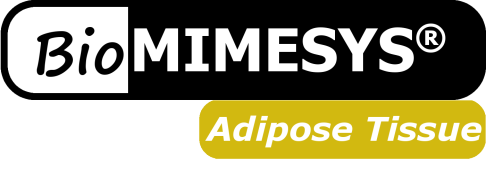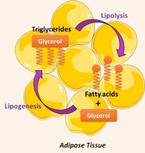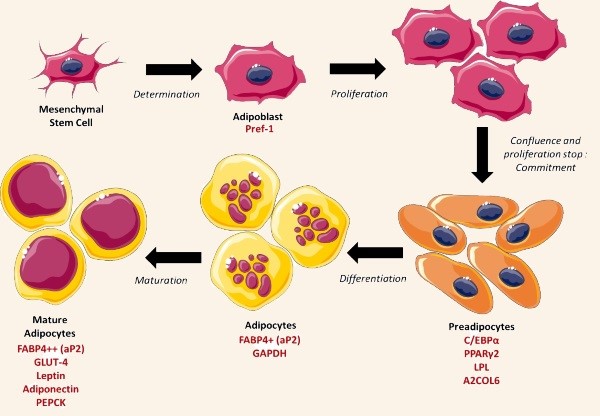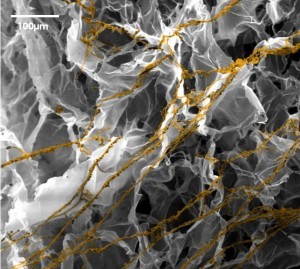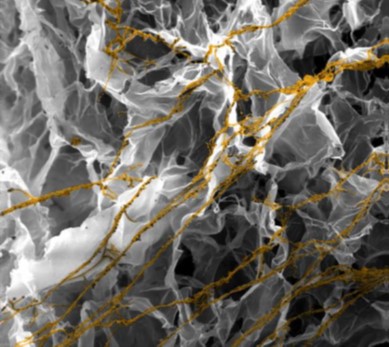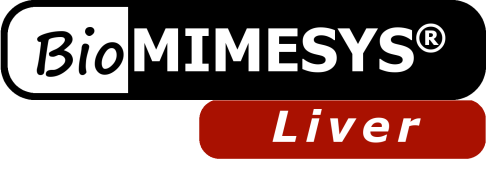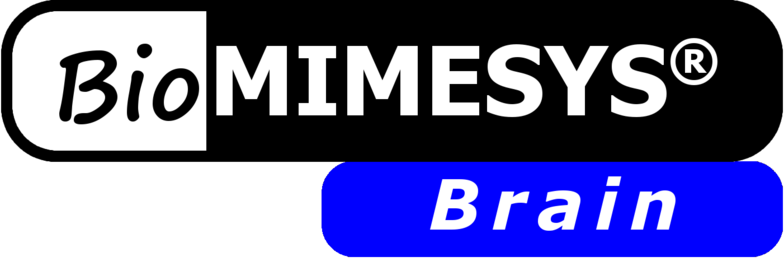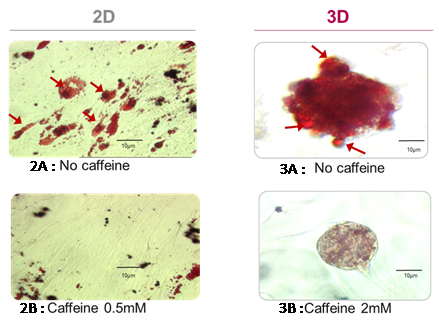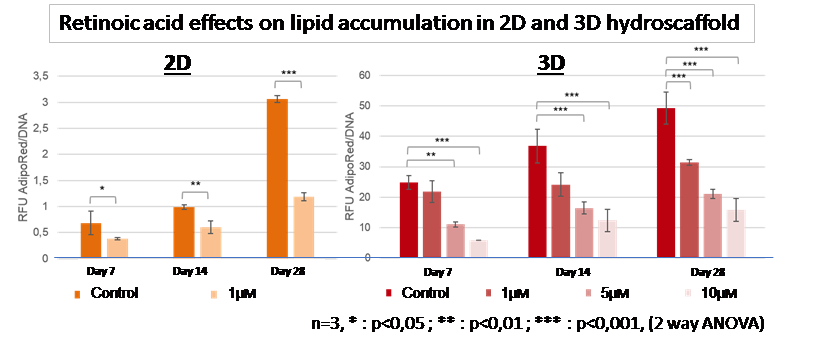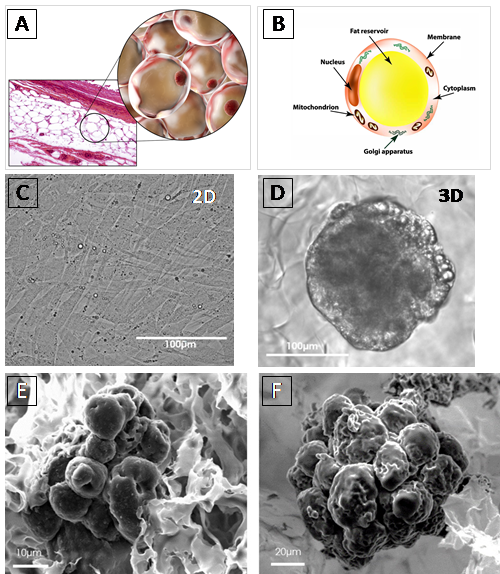Product Details
BIOMIMESYS® Adipose Tissue represents a new generation of mimetic hydroscaffold for 3D adipocyte and adipocyte-like cell cultures. Available in a ready-to-use format, it enables the culture of adipocytes and adipocyte-like cells under physiological conditions that are representative of the microenvironment found in adipose tissue. The highly porous nature of the scaffold allows the rapid uptake of nutrients, oxygen, etc. into the cells to create a reproducible study model for all downstream analyses used with 3D adipocytes culture.
Composed of hyaluronic acid (HA) - a major component of the cell’s extracellular matrix (ECM) - biofunctionalized with adipose tissue ECM components (Collagens type I and VI and cell binding domain of Fibronectin), the BIOMIMESYS® Adipose tissue hydroscaffold for 3D adipocyte-like cell cultures is thus an ideal study model because it is:
• Highly porous for the simple extraction of RNA and proteins
• Transparent for direct visualization of cells
• Representative of the adipocytes' microenvironment in terms of cell-cell interactions, matrix composition and cell-matrix interactions
• Hyaluronic acid (HA) + Collagen I & VI system, is a major component of the adipocyte extracellular matrix (ECM), where it plays an important role in connective tissue.
Hyaluronic acid (HA) + Collagen I & VI system, is a major component of the adipocyte extracellular matrix (ECM), where it plays an important role in connective tissue.
• HA-based scaffolds are formed by HA-grafted RGDS + Collagen I & VI system crosslinking HA with ADH to form reticulated chains.
HA-based scaffolds are formed by HA-grafted RGDS + Collagen I & VI system crosslinking HA with ADH to form reticulated chains.
• High molecular weight HA is made from Gram+bacteria, which makes it easily reproducible.
High molecular weight HA is made from Gram+bacteria, which makes it easily reproducible.
• PHYSICOCHEMICAL FEATURES
PHYSICOCHEMICAL FEATURES
> Porosity: 120 ± 50μm
> Rheology: Young’s modulus: E= 0.45 ± 0.05kPa
> Swelling ratio = 60 ± 10g/g
Ready to Use
BIOMIMESYS® Adipose tissue is EASY & READY TO USE. Upon receiving the vacuum sealed 96-well plate, open it (under a hood) and add the cells directly on top of the matrix. Changing the culture medium is easy as well. To remove medium, simply draw the medium with a pipette between the matrix and the edge of the well. To refresh the medium, place fresh medium onto the surface of the matrix.
Compatible Technologies
BIOMIMESYS® hydroscaffold has many properties (transparent, porous & biodegradable) that make it ideal for use with numerous downstream applications. The growing cells are easily retrieved from the matrix by a gentle and rapid procedure, meaning that cells cultured in BIOMIMESYS® may be analyzed using all technologies as shown below.
TRANSPARENT --- Microscopy, Plate Reader (OD, fluorescence, luminescence)
BIODEGRADABLE --- Flow cytometry
SOLID --- Histology
Proof of Concept
References
1. Louis, F. et al. A biomimetic hydrogel functionalized with adipose ECM components as a microenvironment for the 3D culture of human and murine adipocytes. Biotechnol Bioeng 114, 1813–1824 (2017).
2. Neels, J. G., Thinnes, T. & Loskutoff, D. J. Angiogenesis in an in vivo model of adipose tissue development. FASEB J 18, 983–985 (2004).
3. Cristancho, A. G. & Lazar, M. A. Forming functional fat: a growing understanding of adipocyte differentiation. Nat Rev Mol Cell Biol 12, 722–734 (2011).
4. Dalby, M. J., Gadegaard, N. & Oreffo, R. O. C. Harnessing nanotopography and integrin-matrix interactions to influence stem cell fate. Nat Mater 13, 558–569 (2014).
5. McBeath, R., Pirone, D. M., Nelson, C. M., Bhadriraju, K. & Chen, C. S. Cell shape, cytoskeletal tension, and RhoA regulate stem cell lineage commitment. Dev Cell 6, 483–495 (2004).
6. Wang, L., Johnson, J. A., Zhang, Q. & Beahm, E. K. Combining decellularized human adipose tissue extracellular matrix and adipose-derived stem cells for adipose tissue engineering. Acta Biomater 9, 8921–8931 (2013).
Adipocyte
The major role of the adipocyte is to store (lipogenesis) and release fat (lipolysis) energy reserves of the body. The phenomena of lipogenesis and lipolysis can be controlled by, among other things, the secretion of adipokines from adipose tissue. This secretion can have autocrine, paracrine or endocrine effects. Deregulation of lipolytic mechanisms plays a role in many diseases (e.g. obesity, diabetes).
Lipogenesis – An Important Role of Adipocytes
Lipogenesis is the process of storing the free fatty acids (FAs) in the form of triglycerides (TGs) within droplets leading to mature adipocytes. These mature adipocytes are composed of a single lipid vesicle, a nucleus present at the periphery of the cell and a very thin cytoplasm. If necessary, TGs are hydrolyzed by lipolysis and glycerol is released (1).
Adipogenesis is a phenomenon characterized by chronological changes in the expression of many genes, in two stages:
1) Proliferation of preadipocytes,
examples of early markers:
• Lipoprotein lipase: LPL
• C / EBPα
• PPARγ2
• FABP-4
2) Differentiation: increased lipogenesis and
insulin sensitivity, markers amongst others:
• Perilipin
• ATPcitratelysase
• Malic enzyme
• AcetylCoAcarboxylase
• LHS
• Glut4
Cell Culture Mimicking the Fat Cell Microenvironment
The development of cell cultures capable of mimicking (in vitro) the development of adipose tissue in vivo, is still an experimental field within the study of the physiology and function of adipocytes. This endeavor was originally undertaken investigative challenges on animals or on isolated cells, but new cell models also allow the evaluation and drug screening of therapeutic interest.
Adipocytes differentiated in 2D do not express adipocyte genes in the same way adipocytes would in vivo. The confluence found in 2D and the lack of cell-cell or cell-ECM interactions results in a heterogeneous culture, with a population of undifferentiated adipocytes (fibroblast shape). This model seems less predictive in the study of diseases such as diabetes or obesity (1).
Cristancho (2), Dalby (3) and Mc Beath (4) have independently shown that a spheroidal cell shape, accompanied by a physiological composition of the extracellular environment, allows researchers to strongly induce the differentiation of preadipocytes.
On this basis, HCS Pharma has developed a 3D hydroscaffold, whose composition and organization are similar to in vivo adipose tissue by including collagens I, VI and fibronectin (RGDS pattern) in a cross-linked hyaluronic acid gel.
BIOMIMESYS® Adipose tissue (left) and decellularized human adipose tissue in vivo (5) (right)
Figure 1 : SEM picture of BIOMIMESYS® Adipose tissue (collagen chains are artificially stained in gold)
In order to demonstrate the induction of adipogenesis by the HCS Pharma hydroscaffold, BIOMIMESYS® Adipose tissue, various tests were performed on two cell types: 3T3-L1 and Human White Preadipocyte (HWP) according to the following culture protocol.
Protocol: as in 2D culture, seeding and differentiation steps are induced from day 0 (for HWP and 3T3-L1) until complete maturation.
SEM picture with artificially stained collagen
 | ||||
.....................................................
.....................................................
Iwai North America Inc.
541 Taylor Way Suite# 4
San Carlos, CA 94070
Phone : (650) 486-1541
Fax : (650) 394-8638
Open weekdays 9 AM-6 PM (PST)
.........................................................................................................................................................................................................................................................
BioMIMESYS® is an organ-specific Extracellular Matrix (ECM) formed by the crosslinking reaction of hydrosoluble modified hyaluronic acid (HA) and other ECM components (collagens, fibronectin, etc.) with ADH (Adipic acid dihydrazide), to create a "Hydroscaffold" 3D cell culture system.
About BIOMIMESYS® Adipose Tissue
Lipid accumulation of 3T3-L1 (murine preadipocytes) cultured with or without retinoic acid in BIOMIMESYS® Adipocyte or in 2D was evaluated using the AdipoRed ™ kit, normalized by DNA level.
As low as 1µM of retinoic acid showed significant inhibition of lipid accumulation in 2D (P<0.05), whereas at least 5µM was needed for adipocytes grown in BIOMIMESYS® Adipocyte (p<0.01) at day 7.
Oil red O staining was used to evaluate the inhibitory effect of caffeine on lipogenesis. Preadipocyte, HWP, showed accumulation of lipid in both 2D and 3D environment when caffeine was not present (2A and 3A). To inhibit the accumulation of lipids in 3D (3B), 4 times higher concentration of caffeine was necessary compared to 2D (2B). (Light microscopy images, at day 10 in nutrition period).
Retinoic acid (RA) and Caffeine are reference molecules known for their inhibitory activity on lipogenesis.
RA inhibits adipogenesis by blocking adipogenic factors, caffeine molecule reduces lipid accumulation by adipocytes.
Figure: A and B: Adipocyte schematic morphology in vivo. C and D: Light-microscopy images of adipocyte differentiated from preadipocyte HWP (Human white preadipocytes) at 7 days after seeded. HWP cultured in 2D exhibited a fibroblastic appearance (C), whereas in BIOMIMESYS® Adipocyte, it was resembling morphology of mature adipocytes in vivo, showing the establishment of their principal function, fat accumulation, resulting in the presence of vesicles (D). E and F : SEM images of 3T3-L1 (murine preadipocytes) at day 7 (E) and HWP at day 14 (F), both were cultured in BIOMIMESYS® Adipocyte. In the hydroscaffold, adipocytes formed aggregates which increased in size over time.
Request a Free Sample
Please contact us for more information about a free sample of BIOMIMESYS Adipose. A representative from our sales team will be in contact with you as soon as possible.
